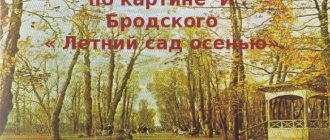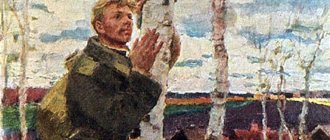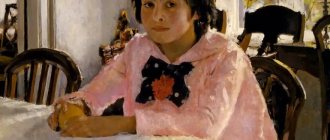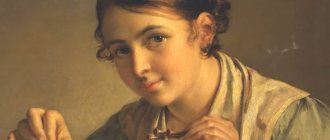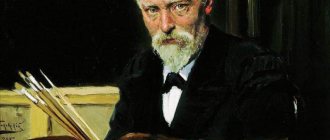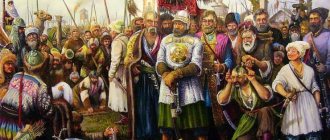Fyodor Petrovich Tolstoy - an outstanding Russian artist, artist, excellent sculptor was born in 1783, in the family of the head of the commissariat. According to tradition, he followed in the footsteps of his father and began to study military affairs. To do this, he entered the naval cadet corps. But his boundless love for art got the better of him, as a result of which he retired from military service in 1804, deciding to forever connect his life with painting and sculpture. F.P. loved to write most of all. Tolstoy flowers, butterflies, wonderful birds, fruits. One of his most famous creations can rightfully be considered the painting “Flowers, Fruits, Birds”. The still life itself is literally imbued with tenderness, fabulousness, warmth, saturated with the aroma of flowers and fruits, and flooded with sun. Flowers, fruits, birds
On a golden-brown background there is a picture of a blown glass vase in which unusual flowers flaunt, the paints for which the author chose deliberately delicate pastel shades - lilac-lilac and white-pink, and only one flower stands out from the general background with brighter yellow-red colors, which does not spoil the overall picture at all, but rather enlivens it. The stems of flowers amaze with their elegance and strength; they seem to be directed upward towards the sun and are fraught with life. Around the vase are laid out apples that shine, glow from the inside, their skin shines glossy in the sun. A small bug is crawling on one of the apples, the other is cut open. Perhaps this is how the artist wanted to show the ripeness of the fruits that he collected for the still life. Next to the apples lies a bunch of grapes with large and juicy berries, it is clear that it was cut recently and the leaves have retained their vitality, the tendrils - the shoots are directed upward and seem to stretch towards the sun.
Bouquet of flowers, butterfly and bird. A small bird with thin legs and bright blue plumage sits on top of the vine. This bird seemed to come down to us from a fairy tale. What could have interested her so much? Where is she looking so intently? And she was most likely interested in a small dot - the movement of a worm that had taken a fancy to the apple, and now she is patiently waiting for it to emerge from its hiding place. Or maybe she admires her reflection in a vase? Or was it the ripe currants that caught her attention? Everyone will answer this question for themselves, because perhaps the artist deliberately left this a mystery. In the middle, near the vase, the author depicted two clusters of currants - one red and the other white. The berries on both clusters are ripe and transparent. The entire still life is saturated with the alluring smell of flowers and the sweet aroma of fruits surrounding the bouquet. This, of course, could not go unnoticed and two wonderful butterflies flocked to this intoxicating fragrance. It is clear that the artist put his whole soul into creating the picture, saturating it with sun, sensuality, and colors. To this day, art connoisseurs never cease to admire his creation, which anyone can see in the Tretyakov Gallery.
Are you doing renovations in a country house and don’t know where you can find good pipes for sewerage and water supply? In this case, I recommend using a specialized store, which is presented at https://msanmarket.ru
Everyone knows the work of the famous artist Fyodor Tolstoy “Flowers. Fruits. Bird”. As for its content, it certainly belongs to still lifes. A bit of history, still life as a writing style began to emerge in the twenty-seventh century in the Netherlands. At that time, science and all its branches were widespread. That is why writers and artists began to try to capture the living nature that surrounds people, to show all its deep inner world. As a rule, they chose flower arrangements, plants, fruits, vegetables, and so on to depict them in their paintings.
In this work, the main place is occupied by a vase with ordinary, fresh flowers that decorated many areas. One of the flowers is the pansy flower, with bright yellow petals and a red-dark center. In addition to it, flowers of delicate and almost snow-white flowers were chosen. The stems and leaves of each of the flowers presented are green, this can only mean one thing, all the flowers used were relatively recently cut, and are still quite fresh.
In a glass vase filled with fresh water, stems and leaves are reflected. Near the vase on a wooden table, various fruits and berries are carelessly placed, including grapes, apples, and even a sprig of currants. Each fruit is depicted as juicy and ripe, and the berries complement them perfectly. To depict them, the creator of the work does not spare bold colors and a rich color palette. Among the entire color palette, red, orange, yellow, green, and olive colors predominate. To make the work seem more realistic, in addition to all of the above, it also contains creatures that belong to living nature.
For example, on a grape branch there is a barely noticeable bird, which is painted with the same colors as the main composition. Also in the picture there is a butterfly, almost green in color, and a moth flying over the table. The whole picture is located on a wooden table, against a wooden wall, this is also very typical of that time, since in the old days the walls of almost every house were made of wood, and so was the furniture. The entire background color is filled with warm colors and shades, this only shows that the picture was created with love. Each of the colors chosen for her is filled with tenderness, warmth and comfort. And this cannot but evoke a warm response from the audience.
Fyodor Tolstoy, like any artist specializing in still lifes, tries to draw people’s attention to living and inanimate nature, and therefore captures it on one canvas. Well, the audience can only learn to see the beauty in the ordinary.
5th grade, according to plan
Essay No. 2
The painting by Fyodor Petrovich Tolstoy (1783-1873) “Flowers, Fruits, Birds” was written in the genre of classical still life. This is not Tolstoy’s only work in this genre, but most of his previous still lifes (“Bouquet of Flowers, Butterfly and Bird,” “Twig of Grapes,” “Lilac Branch and Canary”) look like tests or sketches for this one of the author’s largest works in the genre of still life. It was written around the 20th year of the 19th century. In addition to painting, Fyodor Petrovich successfully engaged in sculpture, graphics, created theatrical costumes and sketches for royal coins.
Still life, as a genre of painting, shows the viewer the beauty of the things around him - these can be flowers, fruits, dishes and much more. In the painting “Flowers, Fruits, Bird,” Tolstoy combined several animate and inanimate objects: apples, a vase of flowers, a bunch of grapes, several currant branches, a bird, a butterfly, a moth and a fly. And each of them has its own place in the picture.
All the “objects” are located on a simple wooden table, against the backdrop of a wall of planed boards, but the warm yellowish and sandy-orange tones suggest that it is a bright sunny day outside the window, and the whole mood of the picture seems to be saturated with the summer sun’s warmth.
The central place in the composition is occupied by a small bouquet of garden flowers in a thin transparent glass vase. The water in it is so clear that thin stems of flowers and boards of the wall can be seen through it, and the glare of sunlight falling from the window is reflected on the surface of the vase. The flowers themselves are fragile and delicate, one branch with three white inflorescences with pale blue veins, the second with four creamy-pink flowers and one unopened bud, the third flower resembles a yellow-brown pansy with red veins. Against its background, the light flowers themselves seem transparent. A few green leaves dilute the bouquet.
Around the vase are several ripe red-green apples and one half of an apple. The cut of the fruit is painted so subtly and precisely by the artist that there is an irresistible desire to try it. There is a fly sitting on the apple on the far left; it, apparently, was also seduced by the ripeness and beauty of the fruit.
To the right and slightly behind is a bunch of green grapes. The berries are painted so realistically that it seems like they were just picked from the vine; there are even traces of morning dew on the berries, as if they were slightly fogged up. From a branch of grapes with two fresh carved leaves, thin twisted tendrils “spread” in different directions, reminiscent of someone’s bizarre rounded handwriting. Maybe this is a kind of signature of the author of the picture?
Perched on the stalk of a grape branch is a small bright bird with a blue “cap” on its head and a blue triangle with a black border on its back. She pressed her greenish wings to her sides, and her black tail provocatively sticks up. The bird tightly grabbed the grape branch with its thin paws, and lowered its head down, as if trying to reach a ripe apple.
In the foreground, several branches of ripe red and white currants hang from the edge of the table. The red berries resemble translucent rubies, and the white ones resemble the buds of an unopened lily of the valley. A butterfly and a small moth flutter around this composition.
The whole picture is painted with such subtlety and grace that not a single detail allows one to doubt its authenticity. The still life seems to be saturated with the sun's rays and warm summer air, which is why one is drawn to touch it in order to feel the carefree childish joy that it awakens in us.
Essay on the painting Flowers Fruit Bird by Tolstoy grade 5
Fyodor Petrovich Tolstoy is one of the representatives of famous Russian artists. On his canvases the master depicts the everyday world around him. The creator’s brush is the beautiful still life “Flowers, Fruits, Bird”.
Fyodor Petrovich captured on his canvas flowers picked in a field, juicy fruits and a bird - everything fully corresponds to the name. The artist gave the audience the opportunity to enjoy the beauty of a summer still life.
Before us is a glass vase with soft pink wildflowers, which probably smell pleasantly. Perhaps this light aroma attracted the butterflies that flutter around here. Delicate, almost transparent flower petals set off the rich green leaves. The clear water in the vase attracts attention, as if it had absorbed a lot of sunlight and is now shining with it.
There are fruits and berries around the vase. A scarlet bunch of currants stands out in the foreground. Its berries were mixed with another yellow variety, they seemed to be intertwined with each other, becoming one. We can also see large, juicy, ripe apples. Their sides were filled with bright red and yellow. The still life is complemented by a bunch of dark green grapes.
On a vine near an apple there is a small graceful bird. She tilted her little curious head down, and her pointed tail went up. The little songbird seems to be looking for something on the apple, probably what attracted her to this still life. Its feathers shimmer in brown and blue-black.
The painting by Fyodor Petrovich Tolstoy is flooded with bright light. The bright, rich palette of colors that the artist uses evokes a feeling of warmth and comfort in the soul. On a hot summer day, the viewer seemed to be able to get onto the summer veranda, where the beauty of nature awaits him. Still life emphasizes the harmonious combination of living and inanimate nature.
Currently reading:
- Essay based on a painting by Nyssa February.
Moscow Region 5th grade Georgy Grigorievich Nissky is a painter who put his soul, feelings, and emotions into every creation of art. All this now makes his paintings real and heartfelt. Georgy Grigorievich constantly painted landscapes. - The main characters of The Master and Margarita essay
The main characters in Mikhail Afanasyevich Bulgakov’s novel “The Master and Margarita” are Woland, the Master and Margarita. Woland meets already at the very beginning of the novel. He is a middle-aged man, cunning, Satan, the Devil, the powerful “prince of darkness”, - Moral problems in Ostrovsky's play The Thunderstorm essay
Ostrovsky's work "The Thunderstorm" undoubtedly hides many problems that should make the reader think about his life, about the life of his relatives and about the life of the society in which the individual lives. Among the problems the writer identifies the following. - Essay: A humorous story about a real-life incident, grade 5.
Once upon a time, an incredibly funny story happened to me. Our whole family came to the village for the summer. Me and my dad were going fishing. We didn’t have to go far, because the river was right behind the garden. - The Cherry Orchard - drama, comedy or tragedy?
Essay For many decades, theater critics have been arguing about what genre the play “The Cherry Orchard” can be classified into: drama, comedy or tragedy, and have never come to a consensus. A.P. Chekhov himself defined it as a comedy, of course, the author knows better. No wonder he - Essay My family in the Great Patriotic War
We live in a civilized world, where progress, new technologies reign, and we do not deny ourselves anything. And, of course, many of us do not understand what our great-grandfathers, grandfathers, great-grandparents experienced during the Great Patriotic War.
» Essay based on F. Tolstoy’s painting “Flowers, Fruits, Birds”
Preparation for written work
Before writing an essay on the painting “Fruits and a Bird,” you should carefully examine the canvas to understand the artist’s intention. The teacher’s task in such a lesson is to teach the children how to correctly construct a descriptive essay. By the way, with such preparation in class, you can prepare a short story about such a genre of painting as still life. After all, as you know, children are always interested in new knowledge, and such material will help them to navigate well in the world of painting in the future.
It is known that this word itself is borrowed from the French language and, in its exact translation, means “dead nature.”
This genre of painting first appeared in the seventeenth century in Holland, and in Russia it became known only in the eighteenth century. Therefore, this topic can become the first point of the plan, which is mandatory when writing an essay. But you can insert a story about the artist into this paragraph. It will be easy for any student to write an essay according to this plan:
- F. P. Tolstoy is a talented artist.
- A wonderful still life.
- Feelings evoked by the painting.
Other works of the artist can be mentioned in the essay, but they should not be described. You can also draw up a complex plan for your work, where there will not only be three main points, but the second part of the essay can be divided into the following paragraphs:
- Wonderful vase with flowers.
- Juicy fruits.
- Multi-colored butterflies and a small bird.
In written work, which in the fifth grade is small in volume, no more than one or two pages, you need to be able to convey what feelings the student experiences when looking at the canvas. In such an essay, it is necessary to describe not only what is depicted, but also what color scheme the artist used and what Fyodor Tolstoy wanted to convey with his canvas.
Essay based on F. Tolstoy’s painting “Flowers, Fruits, Birds”
Before our eyes is a painting by the famous artist Fyodor Tolstoy
. This work can easily be classified as a still life.
F.P. Tolstoy is a famous artist of the twentieth century, who is characterized by a distinctive feature of his paintings. His works were equally admired by his colleagues and art connoisseurs. The artist especially loved to depict flowers and fruits.
Once you look closely at the picture being described, you immediately see the lightness of the colors and the simplicity of the plot. The beauty of the picture is given by the image of a vase with white and pink flower buds. Tenderness and beauty are inherent in the master’s brush.
In the picture, only one flower is painted in a brownish tint; it in no way introduces disharmony into the composition, but, on the contrary, gives it a special charm. Each stamen is drawn in detail, and the water in the vase seems crystal clear. Each stem is clearly visible, and the long leaves bend over, as if hugging the inflorescences.
The currant berries are transparent and light, innocently located near the vase. Thanks to such transparency, you can even see grains in them if you wish.
Juicy red apples calmly sleep around the vase, and next to them is a bunch of grapes with a vine. All this seems so fresh and pleasing to the eye that you involuntarily begin to feel a pleasant fluid that flows into the most remote corners of your consciousness. The leaves on the vine haven’t even had time to wither yet.
A bright background in golden tones implies sunlight and brings joy to the mood. The picture radiates considerable vitality, and living creatures are present everywhere: butterflies flutter around the fruit, we see a bug crawling on an apple, a bird of wondrous beauty is located on a grape branch.
The bird's head and back are blue, its belly is yellow, its wings are green and gray. She hovered over the apple and tried to get it with her beak.
The special technique of painting is also manifested in the fact that F.P. Tolstoy did not place flowers and fruits in any specific object. They are presented as light and floating in space, creating the impression of unity and uniqueness of living and inanimate nature.
The only moment of the presence of people in this small world is revealed by a cut apple, but it does not cause negative illusions, but rather emphasizes the unity of nature and man.
Following the traditions of the “Still Life” genre, the artist filled his painting with radiant light, where flowing warmth gently warms the soul. This warmth is carried by a blade of grass, a flower, a butterfly or a dragonfly.
Even during the formation of this genre (approximately the seventeenth century), artists sought to depict the unity of nature and man. This direction in painting has not become outdated in the modern era.
F. Tolstoy, following the postulates of the “Still Life” genre, tried to focus people’s attention on the beauty and uniqueness of nature, to instill a sense of beauty.
Therefore, this work is considered unique, wonderful and full of creative thoughts.
Essay on the painting Flowers, Fruits, Birds by Tolstoy
The picture shows a vase in which there is a bouquet of flowers and a butterfly flying around, one can assume and imagine that the flowers smell nice and the insect simply cannot fly past it.
Attention is drawn to the brightness of the selected colors and the artist’s ability to convey all the naturalness of the bouquet and fruit. Near the vase there are apples, since the artist painted them with a shiny side, you can imagine that they are just picked and delicious.
Likewise, the row of grapes that was placed near the apples, you can see from the edge that it was recently cut, beautiful green leaves, the grape berries themselves are large and shiny.
Looking at this picture, we can say with confidence that the artist painted this picture with love, he wanted to convey the beauty that quite often we simply do not notice. This picture can be hung at home, for example, in the kitchen. It is positive, warm, and besides, it depicts such delicious fruits, and the bird that sits on the apple only confirms the guess that the apple is really tasty, juicy, you simply cannot find anything better.
Tolstoy Fyodor Petrovich is known to many as a Russian artist. He painted many pictures, but even before he started painting, he became a military man, just like his father. He entered the naval school, but the thought of drawing haunted him.
Most of all he liked to draw nature, especially butterflies, various birds, flowers, fruits, everything that could please and lift his spirits. That is why his main painting, which many people like, became “Flowers, Fruits, Birds.” What is shown in the picture is called a still life. If you look at it, you will see how light and warm it is, the fruit is like real ones, it seems that if you listen you can hear a bird pecking at an apple.
If desired, paintings by this artist can be seen in the Tretyakov Gallery.
Popular topics today
More than anything else, Aivazovsky liked to paint not only the sea, but also different cities and countries. He often visited Turkey, which is why you can see this country in many canvases.
The painting by A. Plastov, The Fascist Flew By, depicts a landscape of early autumn. At this time, a variety of colors are observed in nature. The cold has not yet set in, and nature is taking advantage of the last warm days.
In 1835, the famous artist Alexander Ivanov went to Italy. Since he had no funds of his own, the trip was sponsored by the art society in which he was a member.
When you look at the works of Viktor Mikhailovich, you are immediately transported to the world of a fairyland. Perhaps even small children love his works.
For peoples who keep their own traditions and exist in harmony with nature, interaction with other species of living beings is more than natural.
Essay on the painting Flowers, fruits, birds for grade 5
The painting by Fyodor Petrovich Tolstoy depicts a still life. There is nothing fancy here, but such a prostate has its own charm. The painting consists of simple elements, and this is the charm of this painting. What is depicted here is exactly what the title says - a bouquet of flowers in a vase, fruit and a bird about to eat an apple.
When you look at the painting, you get the feeling that it was created at the end of summer, because the artist used warm colors in the color of the passing summer. This is also noticeable by the fact that ripe fruits are depicted here: apples, grapes, currants.
In the center of the picture there is a transparent glass vase, and in it there are probably freshly picked flowers, because the water filling the vase is still completely clean. Among the delicate white and pink flowers, one dark one can be seen, which creates contrast. Butterflies flutter cheerfully around the fragrant flowers.
The fruits look very realistic. I think it’s the patina that gives grapes such believability, the small wormholes that give apples, and the transparency of currants. The fruits look very appetizing. The artist could not resist and cut one of the apples in half. Apparently, this was quite recently, since it had not yet had time to darken. How beautifully the fruits shine in the sunlight. This gives the whole picture some kind of radiance, a feeling of freshness.
It is difficult to notice the bird in this picture; it is bending over a ripe apple to taste a tasty delicacy. The bird blends in with the greenery surrounding it, with only its tail sticking out above an armful of fruit.
Things that seem ordinary at first glance take on a completely different meaning under the hand of a master. The picture doesn’t seem like a picture at all: it seems as if the bird is about to flutter and fly away. I think that the artist wanted, when looking at the picture, people to think that beauty surrounds us - we just need to look closely.
Description of the picture
A very unusual painting called “Flowers, Fruits, Birds” was painted by the famous artist Fyodor Petrovich Tolstoy. The picture turned out to be sunny, joyful and light colors. In the picture we see a small bouquet of wildflowers of unusual beauty, it is immediately clear that the flower petals are very delicate, even their color emphasizes this, the artist, using a transparent vase, decided to show flexible and thin stems and neat elongated leaves of flowers, they are clearly visible in a pear-shaped vase and clear, clean water, and the flowers themselves simply ooze with tenderness.
Also, beautiful liquid fruits are neatly scattered around the vase. Juicy, appetizing and red-sided apples, one of which is cut and the veins and seeds inside are clearly visible and a bunch of large ripe green grapes, carelessly picked and placed along with leaves, which greatly complement the unusual image of the picture. But in front of the vase lie neat clusters of red and white currants, which seem to be intertwined with each other; they look very impressive against the background of a transparent vase. A miniature, unusual bird is sitting on a bunch of grapes, looking at something on an apple, as if it was going to catch someone and was waiting for prey, or it saw its reflection in the water and was simply looking at it. A motley butterfly flies a little higher above the fruit; one gets the feeling that it is trying to fly as high as possible.
What the still life is standing on is not visible, only blurry boundaries are visible, somewhat reminiscent of a table.
In general, the background of the picture personally reminds me very much of a golden, warm autumn, when the harvest is already being harvested and the last rays of sunshine before the cold weather warm everything around with their warmth. All items are in harmony with each other both in color and location. In general, the picture is quite simple, but it is in this simplicity that the whole point lies. The author seems to want to convey to us that we should not look for beauty somewhere on the side, because the beautiful is next to us, it constantly surrounds us, and unfortunately we do not notice it.
Option 2
A bright, uplifting picture. In a pinkish-beige background, the artist Tolstoy placed many living and non-living objects. The luminous flux falls from the left, darkening the right side of the picture.
In the central part there is an image of a transparent vase. It consists of glass. It reflects the stems of delicate white bells and soft pink lilies.
On the left are juicy apples with red barrels. One of them is cut off and one half lies there. An awakened fly crouched near the second round fruit. Ripe currants lie in front of a transparent vessel. There are white and red berries on the branches.
A nimble bird with a blue crest landed on the right grape branch. The tail is raised up with its black end. A sharp nose rushed out to peck the ripe fruit. The paws firmly grabbed the grape vine. Juicy, oval berries united into a large bunch. An entire branch has been broken off and prehensile tendrils are developing on it. You might think that this is a painting by the main author of the work. The leaves are green, large and have not yet wilted.
Small butterflies fly in the upper left and right corners of the picture, evoking a feeling of movement and a change in action every second.
It’s like I’m standing next to you and inhaling the aroma of delicate beautiful flowers. Enjoying the fragrant fruits. I explore all the variety of different colors, tastes and smells. Generous nature gave them to us and colored our lives with living objects - birds of paradise and butterflies fluttering like blooming flowers.
Peace comes to my soul and the blessed joy of the wonderful gifts of our kind mother nature. When watching the story, time stops and there comes a moment of admiration and pride for your native land and its countless riches. We must appreciate and increase them!
The artist wants to share with us his love for beautiful creative art. And to show that even simple objects on the table are elements of art. Introduce the genre of works of art - still life. All the gifts of our earth are dear to him, and he wants to teach us to enjoy and convey the form and variety of bright colors of our planet.
Description of Tolstoy's painting Flowers, fruits, birds for grades 2, 5
Before us is a canvas depicting garden fruits and flowers in a vase. The still life is executed in a light airy manner and conveys the warmth of colors. The image exudes fabulousness, tenderness, it is saturated with the aroma of flowers and fruits. Pastel shades of lilac, pink and lilac bring it to life, while the yellow-honey background makes it warm and luscious like sunlight.
A realistic glass vase is depicted, around which ripe red apples, grapes and currant branches are laid out, apparently all of them recently picked. The water in the vase is clean and clear, in which the green stems of the flowers are clearly visible. The leaves of the grape bunch delight the eye with their freshness, and the berries of white and red currants are transparent, in which the grains are visible. In a light vase, the stems of garden flowers gracefully curved.
Color spectrum
A simple and colorful still life attracts the attention of viewers with its harmony and integrity, as well as skillfully and talentedly selected colors. The individual style of the master is felt even in the way the paints are applied to the canvas. The artist Tolstoy specifically used warm and light colors for the background to make his painting more expressive and deep. The following colors and shades can be distinguished on this canvas:
- golden;
- pink;
- white;
- green;
- red;
- yellow;
- blue.
On a golden background, the talented artist depicted a transparent vase with beautiful flowers, which are set off by green foliage. There are fruits nearby: apples and grapes.
A beautiful little bird sits nearby, and its head is decorated with blue plumage. On the table the viewer sees red and yellow currants. And two colorful butterflies are circling above this wonderful table.
Participants
Flowers and fruits are not the only participants in the still life. In this artistic micro world, Fyodor Tolstoy depicted other inhabitants of the garden - a bird, a beautiful butterfly and a dragonfly, each busy with their own business. A wonderful bird with blue plumage is perched on a grapevine and is interested in the worm that is hiding in the apple, or maybe it is looking at the berries. The bird flew in as if from a fairy tale and enlivened the picture with its presence. A bicolor butterfly flutters around the fragrant flowers, and a dragonfly appears to be attracted to the cut up fruit. A crawling beetle or ant is visible on one of the apples.
The subject of the canvas
In the center of the canvas there is a transparent vase with clear water, in which plant stems and even the background of the entire picture are visible. In the reproduction of F. P. Tolstoy, the bouquet reminds of warmth and helps create a spring mood. There are green apples next to the vase, and even a fly sits on one of them. On the right side of the vase, the artist depicted a juicy bunch of grapes on which a small bird perched.
But this canvas is still enlivened by the butterflies that hover next to the beautiful bouquet. Nearby lie currant branches, which are so transparent that even the seeds in these berries are visible.
Schoolchildren usually describe this picture in 2nd grade or 5th grade.
The simplicity of the plot and the lightness of the colors give the picture a special charm and beauty of the national island of nature - the garden, which was an integral part of any estate. The artist’s individual style is felt in the canvas. This is expressed in a special technique when painting a picture and detailed drawing of objects. All objects seem to float in space, alive and natural. Even an apple cut in half creates the impression of unity between nature and man. The sunlight coming from the image warms the person looking at it. The shades are so subtly chosen. They convey a joyful feeling and vitality. Each painted bud, stem or moth creates an image of eternity and at the same time the fleetingness of the moment. The flower standing in the vase has a brownish tint, but even this does not spoil the overall life-affirming impression.
